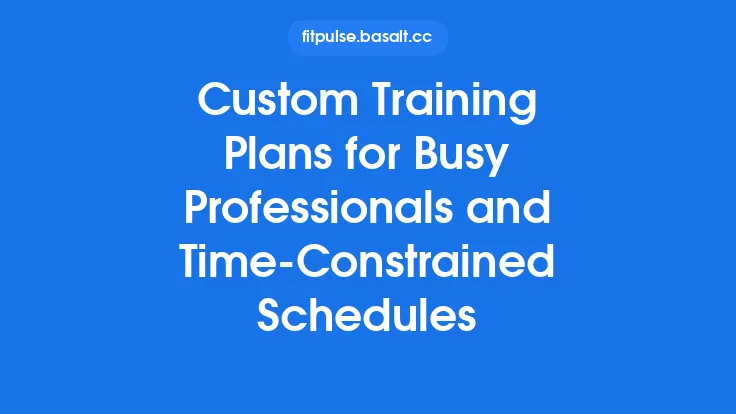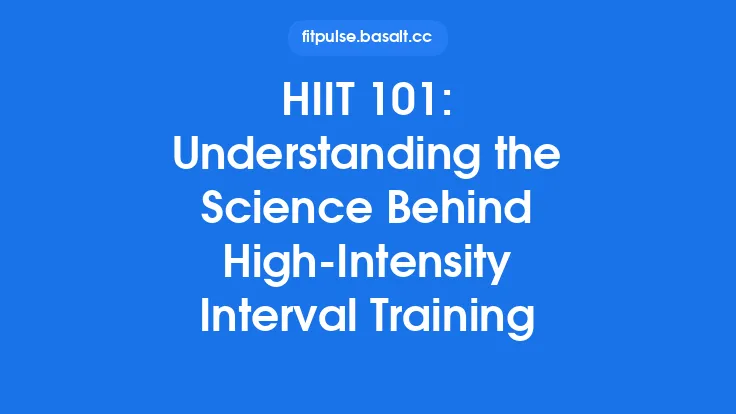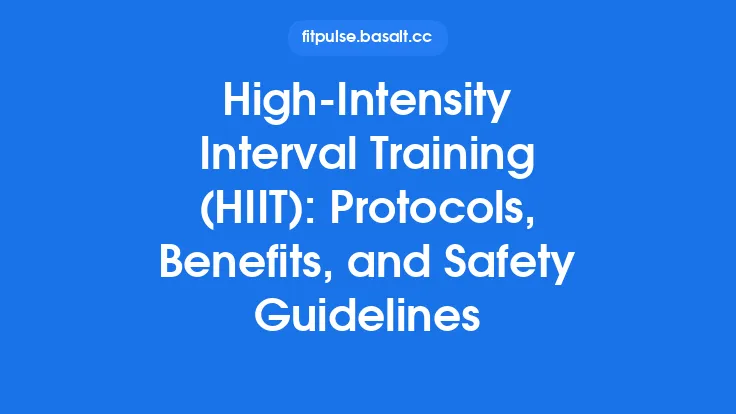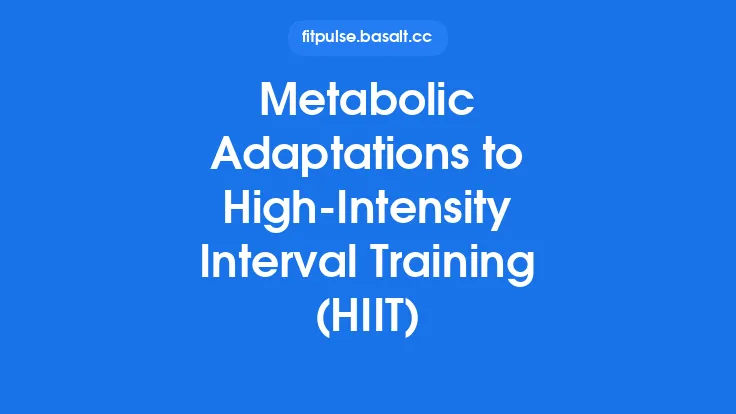High‑intensity interval training (HIIT) has earned its reputation as one of the most time‑efficient ways to improve cardiovascular fitness, metabolic health, and muscular endurance. For professionals whose calendars are packed with meetings, deadlines, and travel, the challenge is not whether HIIT works, but how to embed it into a demanding lifestyle without compromising performance or increasing injury risk. This article walks you through the science‑backed principles, practical programming strategies, and everyday logistics needed to make HIIT a sustainable pillar of a busy professional’s fitness regimen.
Understanding the Constraints of Busy Professionals
| Constraint | Typical Manifestation | Implication for HIIT Design |
|---|---|---|
| Limited Time Slots | 30‑minute windows, often early morning, lunch break, or after work | Sessions must be ≤20 min of active work, plus warm‑up/cool‑down |
| Variable Energy Levels | Fluctuating sleep quality, travel‑induced fatigue | Need flexible intensity scaling and recovery options |
| Irregular Access to Facilities | Home office, hotel rooms, occasional gym visits | Programs should be equipment‑agnostic or use minimal gear |
| High Cognitive Load | Decision‑making and stress throughout the day | Exercise should serve as a mental reset, not an additional stressor |
| Travel & Time‑Zone Changes | Jet lag, disrupted routines | Portable protocols that can be performed in any environment |
Recognizing these constraints allows you to prioritize the most critical variables—duration, intensity modulation, and logistical simplicity—while preserving the physiological benefits of HIIT.
Core Principles of HIIT Adaptation
- Work‑to‑Rest Ratio
- Classic HIIT often uses 1:2 or 1:3 ratios (e.g., 30 s work, 60–90 s rest). For time‑pressed schedules, a 1:1 ratio (30 s work, 30 s rest) can maintain stimulus while halving total session length.
- Adjust the ratio based on the chosen modality (bodyweight vs. cycling) and the athlete’s current aerobic base.
- Intensity Definition
- Peak Power Output (PPO): For cycle or rowing ergometers, target 85–95 % of PPO measured during a baseline 3‑minute all‑out test.
- Heart Rate Reserve (HRR): Aim for 80–90 % of HRR during work intervals, calculated as HRmax – HRrest.
- Rate of Perceived Exertion (RPE): When equipment is unavailable, an RPE of 8–9 on a 10‑point Borg scale reliably reflects the required intensity.
- Progressive Overload
- Incremental adjustments can be made by:
a) Adding 5 % to work‑interval duration (e.g., 30 s → 35 s).
b) Reducing rest interval by 5 s.
c) Increasing resistance or load (e.g., adding a weighted vest).
- Overload should be introduced no more than once per week to accommodate recovery demands.
- Periodization for Lifestyle Variability
- Micro‑cycles (weekly): 2–3 HIIT sessions, interspersed with low‑intensity steady‑state (LISS) or active recovery.
- Macro‑cycles (quarterly): Build a 4‑week “accumulation” phase (gradual overload), followed by a 1‑week “deload” (reduced volume/intensity) to mitigate cumulative fatigue.
Designing Time‑Efficient HIIT Sessions
| Session Component | Recommended Duration | Rationale |
|---|---|---|
| Dynamic Warm‑up | 3–4 min | Mobilizes joints, raises core temperature, primes neuromuscular system. |
| Work Intervals | 30 s – 45 s each | Sufficient to recruit fast‑twitch fibers and elevate lactate. |
| Rest Intervals | 30 s – 45 s (active recovery) | Maintains elevated heart rate while allowing partial phosphocreatine resynthesis. |
| Cool‑down | 2–3 min | Facilitates parasympathetic rebound, reduces post‑exercise dizziness. |
| Total Active Time | 12–16 min | Fits within a 20‑minute window, leaving room for warm‑up/cool‑down. |
Sample 20‑Minute Protocol (Bodyweight Focus)
- Warm‑up: Jumping jacks, inchworms, hip circles (4 min)
- Circuit (repeat 4×):
- 30 s burpees (max effort)
- 30 s rest (walk in place)
- 30 s alternating jump lunges
- 30 s rest
- 30 s plank shoulder taps
- 30 s rest
- Cool‑down: Standing forward fold, chest opener (3 min)
Total active work: 12 min; total session: 19 min.
Modulating Intensity and Volume on the Fly
Busy professionals often encounter days when a full‑intensity session is impractical. The following “intensity knobs” enable rapid adaptation:
| Knob | How to Adjust | Effect on Physiological Load |
|---|---|---|
| Interval Length | Shorten work to 20 s, keep rest at 30 s | Reduces anaerobic contribution, still improves VO₂max over time. |
| Rest Duration | Extend rest to 60 s while keeping work at 30 s | Lowers cardiovascular strain, useful on low‑energy days. |
| Load/Resistance | Use a lighter kettlebell or remove weighted vest | Decreases mechanical stress while preserving metabolic stimulus. |
| Movement Complexity | Switch from plyometric to controlled tempo (e.g., slow push‑ups) | Shifts emphasis from power to muscular endurance, less joint impact. |
By toggling these variables, you can preserve the habit of training even when external stressors spike.
Integrating HIIT into a Workday
- Morning Micro‑Session
- 5 min before the first meeting: a quick “wake‑up” HIIT (e.g., 4 × 30 s high‑knee runs, 30 s rest).
- Benefits: Boosts cortisol rhythm, sharpens focus for the day ahead.
- Lunchtime Power Block
- Reserve a conference room or empty office space.
- Perform a 15‑minute protocol using a resistance band or bodyweight.
- Follow with a brief cool‑down and a protein‑rich snack.
- Evening “Unwind” Session
- After work, a low‑impact HIIT (e.g., rowing machine or stationary bike) for 12 min.
- Helps transition from work mode to personal time, supporting sleep quality.
- Travel‑Ready Option
- Hotel room: 6‑minute “tabata” (20 s work, 10 s rest) using a TRX strap or a suitcase as a weight.
- Airport lounge: Staircase sprints—30 s sprint up, walk down, repeat 5–6 times.
Equipment and Space Considerations
| Scenario | Minimal Equipment | Space Requirements |
|---|---|---|
| Desk‑side | Resistance band, timer app | 2 × 2 m clear area |
| Home office | Adjustable dumbbells or kettlebell (5–15 kg) | 3 × 3 m |
| Gym access | Rowing machine, stationary bike, battle ropes | Standard gym floor |
| Travel | Bodyweight, suitcase, hotel towel | 1.5 × 1.5 m |
When possible, choose equipment that doubles as a functional tool (e.g., a kettlebell for both HIIT and strength work) to reduce clutter and cost.
Monitoring Progress and Recovery
- Objective Metrics
- Heart Rate Variability (HRV): Daily morning HRV can flag insufficient recovery; a drop >10 % from baseline suggests a need for a lighter session.
- VO₂max Estimation: Perform a 3‑minute all‑out cycle test every 6–8 weeks; improvements of 3–5 % indicate effective HIIT adaptation.
- Power Output: Track peak watts on a bike or rowing ergometer; incremental gains reflect neuromuscular improvements.
- Subjective Measures
- RPE Log: Record perceived exertion for each interval; a consistent rise may signal overreaching.
- Sleep Quality: Use a simple 1‑5 scale; poor scores correlate with reduced HIIT performance.
- Energy Levels: Note midday alertness; improvements often accompany successful HIIT integration.
- Recovery Strategies
- Active Recovery: Light walking or mobility drills on non‑HIIT days.
- Hydration & Electrolytes: Essential for maintaining performance during high‑intensity bouts.
- Micro‑stretching: 2‑3 min of dynamic stretches post‑session to aid muscle length recovery.
Nutrition and Lifestyle Synergy
| Nutrient | Timing | Practical Tips for Professionals |
|---|---|---|
| Carbohydrates | 30–60 min pre‑HIIT (e.g., a banana, oat bar) | Choose portable options that won’t cause gastrointestinal distress. |
| Protein | Within 45 min post‑HIIT (15–25 g) | Greek yogurt, whey shake, or a lean turkey roll-up—easy to pack. |
| Caffeine | 15 min before a morning session (≤200 mg) | Can enhance power output; avoid late‑day intake to protect sleep. |
| Hydration | 250 ml water 20 min before, sip during rest intervals | Use a reusable bottle with time markers to ensure consistent intake. |
A balanced diet that supports glycogen replenishment and muscle repair will amplify the adaptations gained from HIIT, especially when training frequency is limited.
Safety and Risk Management
Even though HIIT is time‑efficient, the high metabolic and mechanical demands necessitate a disciplined approach:
- Pre‑Screening: Conduct a brief health questionnaire (e.g., cardiovascular risk factors) annually, especially if you have a sedentary background.
- Movement Quality: Prioritize proper technique over speed; a well‑executed burpee at 70 % intensity is safer than a sloppy one at 100 %.
- Progressive Introduction: Start with 2 × 30 s work intervals per session, gradually building to 4–6 as tolerance improves.
- Joint Health: Incorporate low‑impact alternatives (e.g., cycling instead of sprinting) if you notice joint discomfort.
- Emergency Plan: Keep a phone nearby and know the location of the nearest first‑aid kit, especially when training in unfamiliar environments.
Sample Weekly Plans
Plan A – “Desk‑to‑Gym” Hybrid (4 sessions/week)
| Day | Session Type | Duration | Focus |
|---|---|---|---|
| Monday | Morning micro‑HIIT (bodyweight) | 12 min | Cardiovascular activation |
| Tuesday | Lunch‑hour gym HIIT (bike) | 18 min | Power & VO₂max |
| Thursday | Evening low‑impact HIIT (rower) | 15 min | Metabolic conditioning |
| Friday | Travel‑ready HIIT (band) | 10 min | Muscular endurance |
Plan B – “Minimalist” (3 sessions/week, no equipment)
| Day | Session | Structure |
|---|---|---|
| Tuesday | 20‑min bodyweight HIIT (tabata style) | 8 × 20 s work / 10 s rest |
| Thursday | 15‑min mobility‑integrated HIIT | 5 × 30 s movement + 30 s dynamic stretch |
| Saturday | 12‑min “quick burn” (stairs) | 6 × 30 s stair sprint / 30 s walk down |
Both plans incorporate progressive overload, active recovery, and flexibility to accommodate fluctuating work demands.
Frequently Asked Questions
Q: Can I do HIIT on consecutive days?
A: Yes, provided you vary the modality and keep intensity moderate on the second day (e.g., bike one day, bodyweight the next). Monitoring HRV and perceived fatigue will guide whether a full rest day is needed.
Q: How many calories does a 20‑minute HIIT session burn?
A: Estimates range from 200–300 kcal, depending on body mass, intensity, and post‑exercise oxygen consumption (EPOC). The afterburn effect can add another 5–10 % over the next 24 hours.
Q: Is HIIT suitable for weight loss?
A: Absolutely. The combination of high caloric expenditure, elevated EPOC, and hormonal benefits (e.g., increased catecholamines) makes HIIT an effective tool for fat loss when paired with a modest caloric deficit.
Q: What if I miss a session due to a meeting?
A: A “micro‑burst” of 4 × 30 s intervals can be squeezed into a bathroom break or hallway. Consistency over weeks matters more than perfection in any single day.
Closing Thoughts
For busy professionals, the greatest obstacle to fitness is often not a lack of knowledge but a lack of time. By distilling HIIT into modular, adaptable components—short work intervals, flexible rest schemes, and equipment‑light formats—you can reap the same physiological dividends as longer, traditional workouts while preserving the demands of a high‑pressure career.
The key lies in strategic planning (identifying viable time slots), intelligent scaling (adjusting intensity on the fly), and continuous monitoring (using HRV, RPE, and performance metrics). When these pillars are in place, HIIT becomes not just a workout, but a sustainable habit that fuels both professional performance and long‑term health.
Embrace the science, respect your recovery, and let each 15‑minute burst of effort propel you toward a sharper mind, stronger body, and more resilient career.





